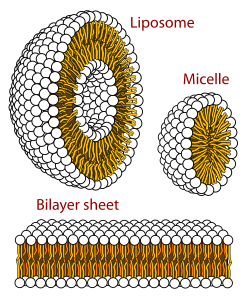
Back Molècula amfipàtica Catalan Amfifil Danish Molécula anfifílica Spanish Molekula anfifiliko Basque آمفیفیلی Persian Amfipaattinen Finnish Amphiphile French Anfipático Galician उभयसंवेदी Hindi Amfifilik ID


An amphiphile (from the Greek αμφις amphis, both, and φιλíα philia, love, friendship), or amphipath, is a chemical compound possessing both hydrophilic (water-loving, polar) and lipophilic (fat-loving) properties.[1] Such a compound is called amphiphilic or amphipathic. Amphiphilic compounds include surfactants (these detergents are commonly called "soap" but are different from traditional soap in both composition and method of action for cleaning). The phospholipid amphiphiles are the major structural component of cell membranes.
Amphiphiles are the basis for a number of areas of research in chemistry and biochemistry, notably that of lipid polymorphism.
Organic compounds containing hydrophilic groups at both ends of the molecule are called bolaamphiphilic. The micelles they form in the aggregate are prolate.
- ^ Betts, J. Gordon. "3.1 The cell membrane". Anatomy & physiology. OpenStax. ISBN 978-1-947172-04-3. Retrieved 14 May 2023.